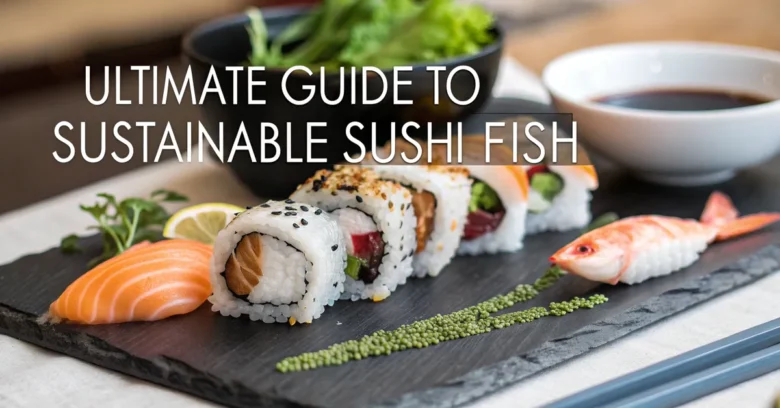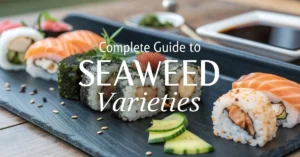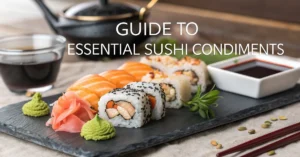Are you craving sushi but also care about the ocean’s health? Choosing sustainable sushi can feel like navigating a minefield. Many popular fish are overfished or caught using methods that harm marine ecosystems. But don’t worry, you can enjoy your favorite rolls while making responsible choices.
This guide cuts through the confusion and provides you with the knowledge to select sustainable fish for your next sushi night. We’ll explore what makes a fish sustainable, highlight specific species to look for, and offer tips for finding reputable restaurants and suppliers. Get ready to indulge in delicious sushi that’s also good for the planet.
What Makes Fish Sustainable?
Sustainability in fishing goes beyond simply having enough fish in the ocean. It encompasses a holistic approach that considers the health of the entire marine ecosystem. Let’s break down the key factors:
-
Healthy Fish Populations: A sustainable fishery maintains a fish population at a healthy level. Scientists monitor fish stocks to ensure they aren’t being overfished, allowing them to reproduce and replenish. The Food and Agriculture Organization of the United Nations (FAO) estimates that 35.4% of global fish stocks are overfished (FAO, 2022).
-
Minimal Bycatch: “Bycatch” refers to the unintended capture of other marine animals, such as dolphins, sea turtles, and seabirds, during fishing. Sustainable fisheries employ methods that minimize bycatch, such as using specialized gear or fishing in specific areas to avoid harming vulnerable species.
-
Habitat Protection: Destructive fishing practices like bottom trawling can damage sensitive marine habitats like coral reefs and seagrass beds. Sustainable fisheries prioritize methods that minimize habitat destruction and protect these vital ecosystems.
-
Responsible Management: Effective fisheries management is crucial for ensuring long-term sustainability. This includes establishing fishing quotas, enforcing regulations, and monitoring fishing activities to prevent overfishing and illegal fishing practices.
-
Traceability: Knowing where your fish comes from is essential for ensuring its sustainability. Traceable seafood allows consumers to track the fish from the boat to the plate, verifying that it was caught legally and sustainably.
Sustainable Sushi Fish Options: A Deep Dive
Choosing sustainable sushi fish can seem daunting, but here’s a breakdown of some excellent choices:
Salmon
Not all salmon is created equal. Farmed salmon, particularly from poorly managed farms, can have negative environmental impacts. Look for:
- Wild-caught Alaskan Salmon: Alaskan salmon fisheries are renowned for their sustainable management practices. The Alaska Department of Fish and Game closely monitors salmon populations and sets strict quotas to ensure their long-term health.
- Farmed Salmon Certified by the Aquaculture Stewardship Council (ASC): ASC-certified farms adhere to strict environmental and social standards, minimizing their impact on the surrounding ecosystem.
Tuna
Tuna is a sushi staple, but many tuna species are overfished. Opt for these sustainable alternatives:
- Albacore Tuna (Troll- or Pole-Caught): Albacore tuna caught using troll or pole-and-line methods are generally considered sustainable. These methods are highly selective, minimizing bycatch.
- Skipjack Tuna: Skipjack tuna populations are generally healthy, and they are often caught using methods that reduce bycatch.
Yellowtail (Hamachi)
Yellowtail, also known as Hamachi or Buri, can be a sustainable choice if sourced responsibly. Seek out:
- Farmed Yellowtail from Certified Sustainable Farms: Look for yellowtail that is certified by organizations like the Aquaculture Stewardship Council (ASC). These farms adhere to strict environmental standards.
Shrimp
Shrimp farming can have significant environmental impacts, including habitat destruction and pollution. Choose:
- Wild-caught Shrimp from Well-Managed Fisheries: Look for shrimp that is certified by the Marine Stewardship Council (MSC) or sourced from fisheries with strong management practices.
Uni (Sea Urchin)
Sea urchin populations can be vulnerable to overfishing. Opt for:
- Sea Urchin from California or Maine: These regions have well-managed sea urchin fisheries.
Other Sustainable Options
Don’t be afraid to explore less common but equally delicious sustainable options:
- Mackerel (Saba): Mackerel is a fast-growing fish that can be a sustainable choice when sourced from well-managed fisheries.
- Eel (Unagi): Choose farmed eel from sustainable aquaculture operations.
- Squid (Ika): Squid populations are generally healthy, and they are often caught using methods that minimize bycatch.
Fish to Avoid (or Eat with Caution)
Some popular sushi fish are facing significant sustainability challenges. Consider limiting your consumption of these species:
- Bluefin Tuna: Bluefin tuna populations have been severely depleted by overfishing. Avoid eating bluefin tuna whenever possible.
- Chilean Seabass: Chilean Seabass, also known as Patagonian Toothfish, is often caught using destructive fishing methods.
- Red Snapper: Some red snapper fisheries are overfished or poorly managed.
- Grouper: Certain grouper species are vulnerable to overfishing.
How to Find Sustainable Sushi
Now that you know which fish to choose, here’s how to find sustainable sushi restaurants and suppliers:
Look for Certifications
Certifications like the Marine Stewardship Council (MSC) and the Aquaculture Stewardship Council (ASC) provide assurance that the seafood you’re consuming is sourced sustainably.
- MSC: The MSC certifies wild-caught fisheries that meet rigorous environmental standards.
- ASC: The ASC certifies farmed seafood that is produced responsibly.
Ask Your Sushi Chef
Don’t hesitate to ask your sushi chef about the sourcing of their fish. A reputable restaurant will be transparent about their sustainability practices.
Questions to ask:
- Where does your fish come from?
- Do you use sustainable fishing methods?
- Are you certified by any sustainability organizations?
Check Restaurant Ratings
Organizations like the Monterey Bay Aquarium’s Seafood Watch program provide ratings for restaurants based on their seafood sustainability practices.
Support Local Fisheries
Whenever possible, support local fisheries that are committed to sustainable practices. This helps to reduce the environmental impact of transportation and supports local communities.
Choose Restaurants with a Commitment to Sustainability
Some restaurants are making a concerted effort to source sustainable seafood. Look for restaurants that:
- Have a written sustainability policy.
- Partner with sustainable seafood organizations.
- Offer a wide variety of sustainable seafood options.
The Environmental Impact of Unsustainable Sushi
Choosing unsustainable sushi has far-reaching consequences for marine ecosystems and the planet.
-
Overfishing: Overfishing occurs when fish are caught at a rate faster than they can reproduce, leading to population declines and potentially the collapse of entire fisheries. According to the World Wildlife Fund (WWF), overfishing is one of the greatest threats to the world’s oceans.
-
Habitat Destruction: Destructive fishing practices like bottom trawling can damage sensitive marine habitats, such as coral reefs and seagrass beds, which are vital for marine biodiversity. A study published in the journal Conservation Biology found that bottom trawling has significant impacts on seafloor ecosystems.
-
Bycatch: Unsustainable fishing methods often result in the unintended capture of other marine animals, such as dolphins, sea turtles, and seabirds. Bycatch can lead to population declines and even extinction of vulnerable species. The National Oceanic and Atmospheric Administration (NOAA) estimates that bycatch accounts for a significant portion of the total catch in many fisheries.
-
Food Web Disruptions: Removing large numbers of fish from the ocean can disrupt the delicate balance of marine food webs, impacting other species that rely on those fish for food. A study published in the journal Science found that overfishing can lead to cascading effects throughout the marine ecosystem.
-
Climate Change: Unsustainable fishing practices can contribute to climate change by damaging carbon-rich marine habitats and increasing greenhouse gas emissions from fishing vessels.
The Future of Sustainable Sushi
The future of sustainable sushi depends on a collective effort from consumers, restaurants, and the fishing industry.
- Consumer Awareness: Increased consumer awareness of sustainable seafood choices is driving demand for responsibly sourced fish.
- Technological Innovations: Advancements in fishing gear and aquaculture technologies are helping to reduce bycatch and minimize the environmental impacts of seafood production.
- Improved Fisheries Management: Effective fisheries management practices, such as catch limits and monitoring, are essential for ensuring the long-term sustainability of fish stocks.
- Aquaculture Development: Sustainable aquaculture practices can help to meet the growing demand for seafood while minimizing environmental impacts.
- Traceability Systems: Traceability systems are becoming increasingly important for verifying the sustainability of seafood products.
Enjoying Sustainable Sushi Doesn’t Mean Sacrificing Taste
Let’s face it, the goal is to enjoy sushi. The good news is that choosing sustainable options doesn’t mean you have to compromise on flavor or variety.
- Explore Different Fish: Step outside your comfort zone and try sushi made with sustainable species you might not have considered before. Mackerel (Saba), for example, has a rich, savory flavor that pairs beautifully with sushi rice.
- Focus on Preparation: The art of sushi lies not just in the fish itself, but also in the preparation. A skilled sushi chef can elevate even lesser-known species with expert knife work, perfectly seasoned rice, and complementary sauces.
- Ask for Recommendations: Don’t be afraid to ask your sushi chef for recommendations on sustainable options. They can often suggest seasonal or lesser-known species that are particularly delicious.
- Embrace Vegetarian Options: Don’t forget about the delicious world of vegetarian sushi! Avocado rolls, cucumber rolls, and vegetable tempura rolls are all fantastic options that have zero impact on fish populations.
Making Informed Choices: Resources and Apps
Navigating the world of sustainable seafood can be challenging, but fortunately, there are many excellent resources available to help you make informed choices:
- Monterey Bay Aquarium’s Seafood Watch: This program provides science-based recommendations for sustainable seafood. Their website and app offer ratings for different species and fishing methods, as well as a restaurant lookup tool.
- Marine Stewardship Council (MSC): The MSC certifies wild-caught fisheries that meet rigorous environmental standards. Look for the MSC blue fish label on seafood products.
- Aquaculture Stewardship Council (ASC): The ASC certifies farmed seafood that is produced responsibly. Look for the ASC label on farmed seafood products.
- Environmental Defense Fund (EDF) Seafood Selector: This tool provides ratings for seafood based on environmental impact and offers recommendations for sustainable choices.
Sustainable Sushi at Home: Tips for Home Cooks
You don’t have to go to a restaurant to enjoy sustainable sushi. Making sushi at home can be a fun and rewarding experience, and it gives you complete control over the ingredients you use.
- Source Sustainable Seafood: Start by sourcing sustainable seafood from reputable suppliers. Look for certifications like MSC and ASC, and ask questions about the origin and fishing methods used.
- Use High-Quality Ingredients: The quality of your ingredients will have a significant impact on the taste of your sushi. Use sushi-grade rice, fresh seaweed, and high-quality seasonings.
- Invest in the Right Equipment: You don’t need a lot of fancy equipment to make sushi at home, but a few key items will make the process easier. A sushi rolling mat, a sharp knife, and a rice cooker are all good investments.
- Follow a Recipe: If you’re new to sushi making, start by following a recipe. There are many excellent sushi recipes available online and in cookbooks.
- Practice Makes Perfect: Like any culinary skill, making sushi takes practice. Don’t be discouraged if your first few attempts aren’t perfect. Keep practicing, and you’ll soon be making delicious and sustainable sushi at home.
Is Sustainable Sushi More Expensive?
You might expect sustainable sushi to be more expensive, but that’s not always the case.
- Supply and Demand: As demand for sustainable seafood increases, prices may become more competitive.
- Less Popular Species: Some sustainable species are less popular than traditional sushi fish, which can make them more affordable.
- Direct Sourcing: Buying directly from local fisheries can often save you money compared to buying from large distributors.
- Value for Money: Even if sustainable sushi is slightly more expensive, you can consider it an investment in the health of the oceans.
Sustainable Sushi: It’s More Than Just Fish
While choosing sustainable fish is the most important factor, there are other ways to make your sushi consumption more environmentally friendly:
- Reduce Food Waste: Only order as much sushi as you can eat to avoid wasting food.
- Skip the Plastic: Bring your own reusable chopsticks, containers, and bags to reduce plastic waste.
- Recycle: Recycle all recyclable materials, such as cardboard boxes and aluminum cans.
- Compost: Compost any food scraps, such as rice and vegetable trimmings.
Supporting the People Behind Sustainable Sushi
The fishing industry is often overlooked, but it is crucial to supporting the fishers, farmers, and communities that are committed to sustainability.
- Fair Labor Practices: Choose seafood from fisheries and farms that adhere to fair labor practices.
- Community Support: Support local fishing communities by buying directly from them whenever possible.
- Economic Incentives: Create economic incentives for sustainable fishing practices by paying a premium for responsibly sourced seafood.
Conclusion: Choosing Sustainable Sushi is a Vote for the Future
The choice is yours. Every time you order sushi, you have the power to make a difference. Choosing sustainable fish is a vote for the health of our oceans, the well-being of marine ecosystems, and the future of the planet. It is time to enjoy your sushi and make responsible choices that will ensure that future generations can enjoy the delights of the ocean as well.



